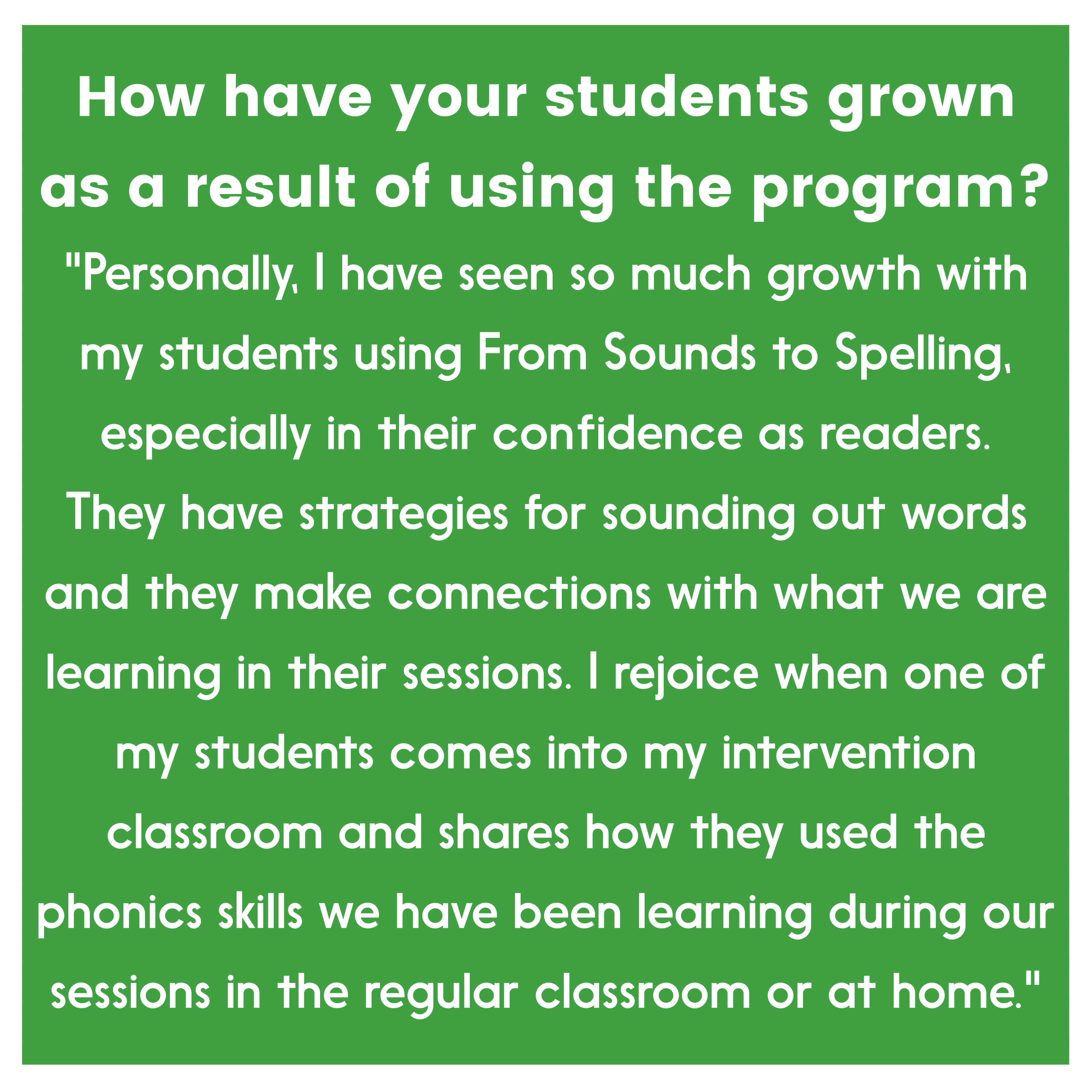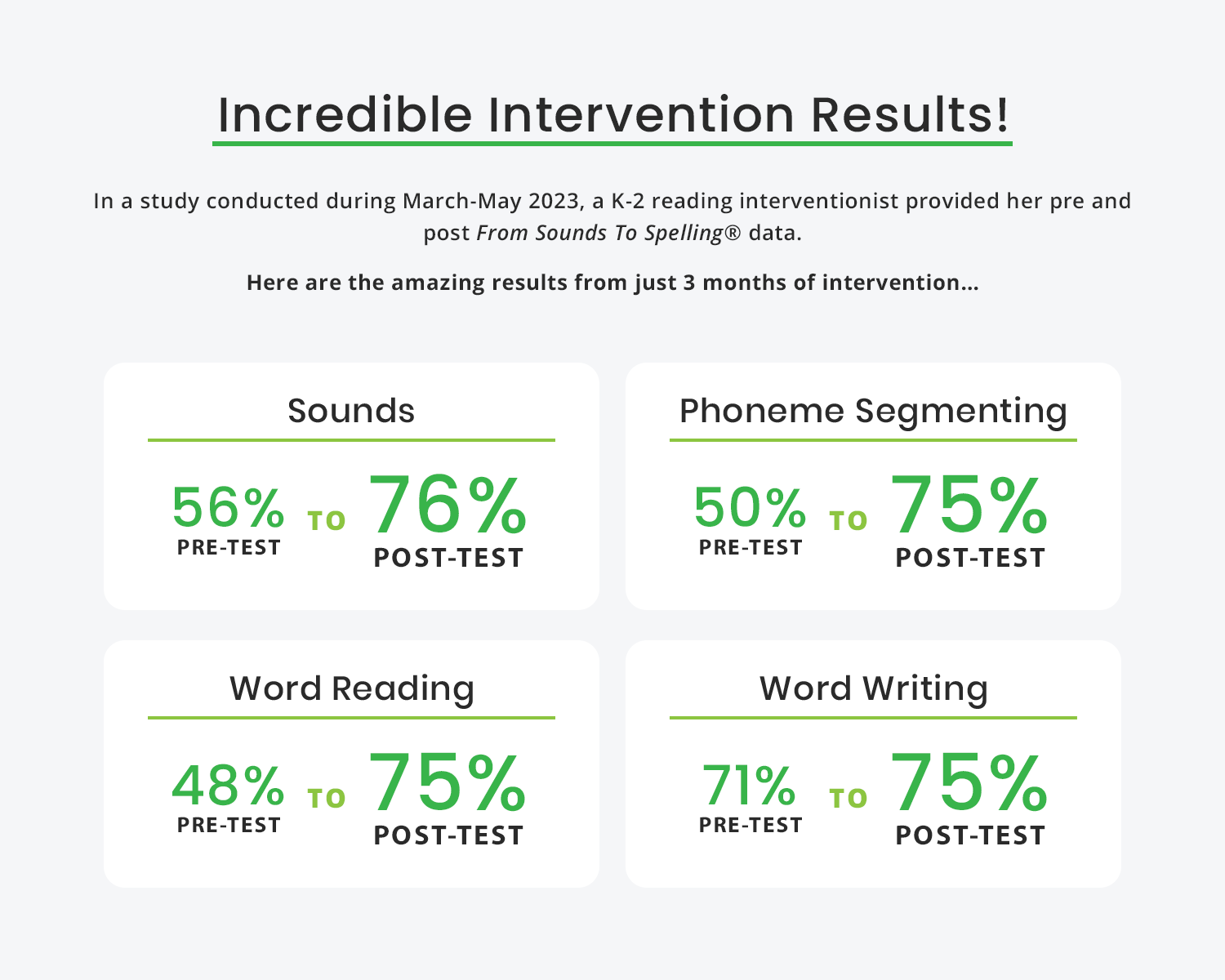
A Reading Interventionist's Perspective: Sarah's Experience Using From Sounds to Spelling
During the last three months of the 2022-23 school year, Title 1 Interventionist, Sarah, used the From Sounds to Spelling phonics program with her reading intervention students. Not only did she see huge improvements in her students' test results, including word reading skills, but her students’ reading confidence also grew!
In this post, we're sharing our interview with Sarah AND her best reading intervention strategies for teachers and reading interventionists using the program! (She has some great tips!)

Q: How did you discover From Sounds To Spelling?
A: After visiting a neighboring school with a strong Title I program and having a discussion with their Title I Director, I felt compelled to search for a phonemic awareness/phonics program for our struggling readers. Shortly after that visit, I received an email from Learning At The Primary Pond, which had me intrigued. I watched an accompanying video that compelled me to sign up for a webinar presented by Alison about From Sounds To Spelling.
Q: How do you structure From Sounds to Spelling for use with students (i.e., individual, small group)?
A: I am the Title I Interventionist for our district and work with the students identified as needing the most support in reading. The students I work with are below their current grade level when assessed. Four or five students are identified from each classroom and are entered into the Title I Intervention program.
The reading intervention program I provided using From Sounds to Spelling with my K-2 students was mainly in a small group format with 4-5 students for 20-25 minutes during their sessions each week.
Q: What does that look like when you're working with a student?
A: When working with my intervention students, I purposely plan a variety of reading intervention strategies and activities in each session. It is important to me that they are challenged, but I also want them to experience the excitement reading brings into their lives. My time with my students is structured to maximize their learning and to give them time to reflect on the progress they are making. Each small group time looks different, even from the same grade level, as I work to best meet the needs of my students. I have back-to-back intervention sessions, and each day my schedule changes. My reading intervention program materials are prepared in color coded bins with matching folders. Once students enter, I share with them a quick overview of what we will be doing and the goals for our time together.

Q: What was your phonics/reading instruction/intervention like before you had From Sounds To Spelling?
A: My first year as the Literacy Specialist providing intervention at the school was very challenging! I did not have many reading strategies for struggling readers or resources and reached out to my local Intermediate School District for ideas. They let me borrow some materials, and I supplemented those with other activities that I found.
Q: What made From Sounds To Spelling stand out to you (versus other phonics programs)?
A: During the free webinar entitled “7 Engaging, Research-Based Phonics Routines to Accelerate Reading Achievement in K-2,” Alison explained more about effective reading strategies for struggling readers to use and introduced From Sounds to Spelling. I took pages of notes. I knew that this comprehensive program would benefit our students.
One thing that impressed me was the understanding and compassion I received when I asked questions of the Learning At The Primary Pond team. Everyone has been so supportive and answered my questions as they have come up throughout these last few months.
Q: What do your students seem to most enjoy about From Sounds to Spelling?
A: Each grade level K-2 seemed to have their favorite part of using From Sounds to Spelling during our final trimester of school.
My Kindergarten groups just jumped up and down when I had the special tablecloth on a certain table because they knew that meant we were practicing finding our letters with Do-a-Dots. This activity was challenging for them because they wanted to rush and be the first one done, but soon they realized that they needed to look more carefully at the letters. My Kindergarten students also really loved the video going through the sounds that letters make with Alison showing them the signs. We would go through the video many days as a wrap-up activity or before they left the classroom.
My first grade groups liked the books I printed for them to take home for practice. They really appreciated the stories printed all on one page, too. We would use different colored highlighters to go find all of the examples of the spelling/word pattern(s) we were working on that day. This provided them a tangible way to show they understood the pattern.
My second grade groups thoroughly enjoyed the learning games we played together to practice the skills from the units in From Sounds to Spelling. Once students knew how to play, they would request to replay the game and gain even more practice. Many of the games I have printed on cardstock and laminated for durability and ease of access. However, my students like when they can take a copy of the game home with them and play again with family. I had very positive comments from my 2nd grade families about them liking the activities/games that I sent home and how it has been fun for all.
Q: What advice would you give to a teacher who is just starting out with the program?
A: The advice I would give a teacher/interventionist is to set aside time to individually give the pre-test to each student. After taking the time to administer and analyze the results of the pre-test, you can easily choose which units your groups need for more support. There is also an included Placement Guide for each level that is extremely helpful to confirm where to begin based on the results of testing. I also highly recommend watching the introduction videos for each level as well.
One big take-away I had to accept was that my intervention students might need two full weeks to get through what is intended to be a week of lessons, and that it's okay. Also, due to the limited amount of time you have with an intervention group, it is important to carefully select reading intervention strategies and activities that give variety, review previous learning, and introduce a new skill or pattern.
We are so grateful to Sarah for sharing her experience using From Sounds to Spelling as a reading intervention program! If you're interested in learning more about how From Sounds to Spelling can make a difference for you and your students, check it out at this link.




